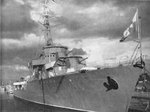Burza
| Country | Poland |
| Ship Class | Wicher-class Destroyer |
| Builder | Chantiers Naval Francais |
| Laid Down | 1 Nov 1927 |
| Launched | 16 Apr 1929 |
| Commissioned | 10 Jul 1932 |
| Decommissioned | 28 Jun 1960 |
| Displacement | 1,400 tons standard |
| Length | 350 feet |
| Beam | 34 feet |
| Draft | 11 feet |
| Speed | 34 knots |
| Crew | 162 |
| Armament | 4x130mm Schneider-Creusot, 1x76mm Mk Vna, 2x40mm Vickers-Armstrong AA, 5x13.2mm Hotchkiss AA, 8x12.7mm Vickers AA, 3 torpedo tubes, 2 depth charge launchers, 2 depth charge throwers |
Contributor: C. Peter Chen
ww2dbaseBurza was a French-built destroyer of the Polish Navy. On 29 Aug 1939, she was among the three destroyers that participated in Operation Peking, aimed at preventing the total loss of the Polish Navy in the likely case of a war with Germany. After an uneventful run-in with German light cruiser Kˆnigsberg and a destroyer, the destroyers made rendezvous with British destroyers Wanderer and Wallace, then at 1737 on 1 Sep they docked in Edinburgh. She remained in service under the Polish banner (though under command of the British Royal Navy) for the remainder of the war. After serving in convoy duties, she became a training ship in 1944, then a submarine tender in 1945. After the war, she became a British warship between 1946 and 1951, then served as a Polish ship again between 1955 and 1960. Between 1960 and 1977, she was a museum ship. Burza was scrapped in 1977.
ww2dbaseSource: Wikipedia.
Last Major Revision: Apr 2007
Destroyer Burza Interactive Map
Photographs
 |  |
Burza Operational Timeline
| 10 Jul 1932 | Burza was commissioned into service. |
| 24 May 1940 | The Polish destroyer Burza was ordered to join the British destroyers HMS Vimiera (L 29) and HMS Wessex (D 43) and shell German positions in Calais area on the French coast. At 1620 hours the Allied vessels opened fire on a German armoured column at Sangatte Hill, west of Calais. Ten minutes later they were attacked by 27 German aircraft which hit and sank HMS Wessex about 5 miles off of the coast. HMS Vimiera managed to escape. Then the entire enemy air group concentrated on the Polish destroyer. The two 40-millimeter anti-aircraft guns jammed due to shrapnel hits. Three bombs exploded in the water and they caused boiler damage and loss of speed. The commanding officer, Lieutenant Commander Wojciech Francki, ordered to emergency launch the torpedoes and drop all depth charges, trying to avoid additional explosions. Shortly after this, two bombs hit the Burza and badly damaged her. However the airplanes had dropped all of their bombs and broke off the attack. The crew managed to stop the leakage and return to Dover, England, United Kingdom. One German airplane was shot down during the action. |
| 28 Jun 1960 | Burza was decommissioned from service. |
Please consider supporting us on Patreon. Even $1 per month will go a long way! Thank you. Please help us spread the word: Stay updated with WW2DB: |
» Operation Peking
» Invasion of France and the Low Countries
- » 1,167 biographies
- » 337 events
- » 44,606 timeline entries
- » 1,243 ships
- » 350 aircraft models
- » 207 vehicle models
- » 376 weapon models
- » 123 historical documents
- » 261 facilities
- » 470 book reviews
- » 28,501 photos
- » 365 maps
George Patton, 31 May 1944
Please consider supporting us on Patreon. Even $1 a month will go a long way. Thank you!
Or, please support us by purchasing some WW2DB merchandise at TeeSpring, Thank you!